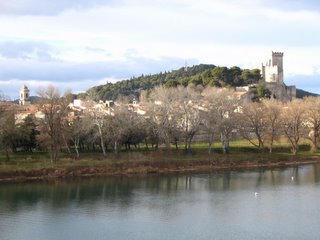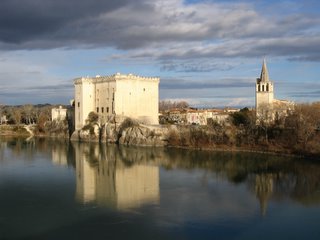Our first blog of the New Year. This morning the bells of Avignon Cathedral were ringing in 2006 and the Italians were letting off the last of their firecrackers before packing-up and returning in convoy to their native land. French radio announced that several hundred cars had been burned across the country during the night, a great increase on last year! The temperature was really mild and all the snow had disappeared. The sun eventually managed to break through the lingering fog and at last we could make our trip to the Pont-du-Gard, a planned highlight of our visit.
We left Modestine well away from the main tourist car park – being too mean to pay the 5 euros parking charge, and with a map marking a track through the surrounding garrigue we were able to combine a warm sunny walk with a spectacular first vista of this famed Roman bridge.
Our solitary stroll took us through a beautiful shrubland of box, bay and wild herbs, almost like a tended garden, alongside the ruins of the aqueduct that had carried water from the Eure at Uzès to the Ponte-du-Gard, supplying the water for the Roman city of Nîmes, a total distance of 50 km with an overall drop in height of only 17 metres.
Emerging onto a rocky promontory we found ourselves looking down on the multiple arches of the bridge as it straddled the Gard, bordered on each side by bare limestone rocks. In summer apparently beaches are created here by importing sand and the banks are lined with temporary cafes and restaurants. How fortunate we were to be here on New Year’s day with bright sunshine and vivid blue skies and only a few other visitors to share it all with.
 Pont du Gard
Pont du Gard Pont du Gard showing all three tiers
Pont du Gard showing all three tiers Pont du Gard from upstream
Pont du Gard from upstream Pont du Gard – again!
Pont du Gard – again!The bridge was constructed some 2000 years ago. Looking at it we were lead to wonder what improvements in bridge architecture have taken place since. Some of the 19th century railway viaducts in Britain are not dissimilar. It has three superimposed rows of arches and the water flowed across the top. An additional single-tiered bridge was built abutting it in the 18th century to add support after the original risked collapsing following attempts to hack holes through the Roman uprights to provide a route across for carts and wagons.
 Pont du Gard showing 18th century supporting bridge
Pont du Gard showing 18th century supporting bridgeWe descended down, crossing on the 18th century supporting bridge to the far bank where we strolled beside the water admiring the structure from every angle. Finally we returned up through the garrigue to explore in more detail the romantic ruins of the lesser known Pont Rou with its many broken arches and tumbled remains of its water course.
 Pont Rou in the garrigue above the Pont du Gard
Pont Rou in the garrigue above the Pont du Gard Ruins of the Roman aqueduct leading to the Pont du Gard
Ruins of the Roman aqueduct leading to the Pont du GardDuring the afternoon we continued to the two towns of Beaucaire and Tarascon, one on each side of the Rhône, linked together by the bridge. The towns seem to vie with each other, both having spectacular riverfront vistas with a prominent castle, a network of old, rather shabby streets and a monster apiece.
Beaucaire has a wealth of beautiful stone houses crowded into its narrow shabby streets. We discovered one particularly pleasant little square of elaborately decorated stone houses. In the centre was the local monster known as the Drac. He has a reputation for eating young women of the town but seemed docile enough today, eagerly accepting some proffered liquorice instead.
 Two dragons meet in Beaucaire
Two dragons meet in Beaucaire A square in Beaucaire
A square in Beaucaire Beaucaire seen from Tarascon
Beaucaire seen from TarasconWe climbed the steps onto the town wall beside the Rhone, protecting it from possible flooding, and crossed to Tarascon on the far bank. It too has suffered serious floods during its history and has constructed similar high defences. It also relies on its monster, the Tarasque to protect it.
 Tarascon seen from Beaucaire – Château du Roi René
Tarascon seen from Beaucaire – Château du Roi René The Tarasque standing guard over Tarascon
The Tarasque standing guard over TarasconAlphonse Daudet, the 19th century writer of such delightful works as Lettres de mon Moulin and Jacques was born in Nîmes and his works are set locally. The town of Tarascon must have mixed feelings about him. Daudet made the town famous in his novel Tartaran de Tarascon, but if we remember correctly, Tartaran was rather a country bumkin and something of a laughable character.
Generally Tarascon seems cleaner, brighter and better maintained than Beaucaire but both are pleasant, interesting places to stroll around. In both there seems to be many Arab residents and we were surprised to see so many groups of young men standing around in groups, not obviously doing anything, or crowded together in certain bars. It is a bank holiday today but we did wonder how many of them are in employment. We did not feel intimidated in any way but it was very noticeable that there were no Arab women on the streets.
We returned to our campsite in Avignon for yet another night, intending to take a walk along beside the Rhône. However, Ian was so tired after our late night and all the walking today he fell asleep in the passenger seat the second we parked at our site!
Monday 2nd January 2006, Arles
Did we mention the strong winds that tend to blow over the Camargue? Known as the Mistral they blow down from the Alps along the Rhône Valley for weeks on end. This evening on our dark and empty campsite in the countryside outside of the city of Arles the wind has risen suddenly and is buffeting Modestine’s sides with great vigour in its attempts to come in to join us!
This morning the sun was shining as we left Avignon and made our way along the banks of the Rhône towards Arles. It’s a pleasant place but after seeing the Roman remains at Nîmes, those at Arles, being less well preserved, do not make the same impact as they otherwise might. We saw a Roman aqueduct running alongside the road, crossing right through the roundabout, and a badly pillaged Roman theatre with a couple of intact marble columns. We walked around the outside of the Arena built to seat 20,000 people – there seemed little point in going inside as it could never rival the one in Nîmes. We sought out successfully the thermal baths of Constantine but had less success locating the Roman circus, despite it being the largest one in existence, somehow it had disappeared on the far side of the multi-lane bypass and we didn’t enjoy the prospect of crossing this on foot.
 Gateway to the theatre, Arles
Gateway to the theatre, Arles Roman theatre, Arles
Roman theatre, Arles Roman amphitheatre, Arles
Roman amphitheatre, Arles Baths of Constantine, Arles
Baths of Constantine, ArlesSo we turned out attention from the Romans to the Christians, investigating the church of St. Trophime with its 12th century portal and nave. Unfortunately it was really poorly illuminated, as are so many French churches, so their treasures cannot be appreciated. There were several huge religious canvases and tapestries but they could have been anything really. Ian was greatly impressed with a 4th century sarcophagus of one of the bishops which now forms the base for one of the side altars. Originally it was placed in the Roman and early Christian necropolis of Alyscamps just outside the city of Arles. Jill preferred the simple lines of the 21st century baptismal font in pink marble, a gift of friendship from Canterbury Cathedral. Neither of us had even a macabre interest in the serried ranks of caskets in metal and glass holding the relics of various saints. It seems strange that people should wish to venerate finger joints, jaw bones, skulls and limbs of frequently doubtful provenance.
 12th century façade of St. Trophime, Arles
12th century façade of St. Trophime, Arles 4th century sarcophagus in St. Trophime, Arles
4th century sarcophagus in St. Trophime, Arles Hôtel de Ville, Place de la République, Arles
Hôtel de Ville, Place de la République, ArlesVan Gogh painted some of his most famous works while living at Arles from 1888. One of his favourite haunts, and inspiration for his paintings, was the Alyscamps. He is honoured by the town today with an arts centre named after him in the former Hôtel Dieu, the hospital where the artist was a patient. Today there was an exhibition of modern artists’ tributes to him. His periods of madness are attributed to the relentless heat of the sun and the merciless whining of the winter wind. We can certainly sympathise with him about the wind but so far our ears are still safely attached to our heads!
 Hôtel Dieu, now the Van Gogh Arts Centre, Arles
Hôtel Dieu, now the Van Gogh Arts Centre, ArlesIt really was uncomfortably chilly, draughty and dangerous in the dark, narrow streets of the old town where pedestrians are forced into doorways every few seconds as cars navigate through streets that were never intended to cope with them. So we made our way to one of the squares and found somewhere for lunch and a chance to warm-up. Our parmentier de veau, served as a small portion on a large plate, was really an example of French nouvelle cuisine applied to shepherd’s pie. Later we sought out the town’s only internet café, crowded with young people playing computer games and making cheap rate online calls home using webcams.
Deciding we had seen the main points, or at least gained a chilly impression, of Arles we went for a short drive in the flat landscape of the Camargue near this campsite. It was a beautiful evening with a brilliant sunset. In the distance we could see the hills, known as les Alpilles, where the Alps finally peter-out - rather as we have done with today’s blog …..
